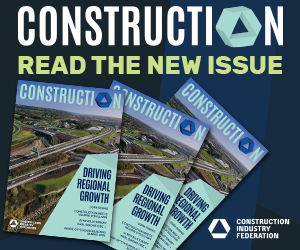Aidan Priestley talks to Kieran McQuinn, a Research Professor at the Economic and Social Research Institute (ESRI), whose focus spans from crafting insightful quarterly economic commentaries to delving deep into the intricate realms of economic growth and housing market trends

Professor Kieran McQuinn
As the National Planning Framework review is due to be released, what’s your scorecard for the current plan?
In assessing the current National Planning Framework, it’s evident that there have been significant policy initiatives over recent years.
Particularly since the aftermath of the global financial crisis, there has been a pressing need for increased government involvement, especially on the supply side of the housing market.
The crisis severely impacted housing construction, leading to a drastic reduction in housing supply from the peak of 85,000- 90,000 units per annum in 2006-2007 to only 5,000-6,000 units at its lowest point.
Over time, the Government has indeed stepped up its efforts, as evidenced by initiatives like Housing for All and increased expenditure on housing.
Approaches such as involving approved housing bodies, local authorities re-entering the housing supply arena, and the establishment of the Land Development Agency have contributed to boosting supply levels.
However, the challenge persists due to the low starting point, necessitating further investment in the coming years.
In our evaluation of the National Development Plan, we highlighted ongoing constraints in the marketplace, particularly concerning labour supply and the planning process, along with broader economic factors like inflation, such as population growth and increased rates of immigration contribute to an upward trend in housing demand.
As such, the targets set for the housing market are likely to be revised upwards to reflect the heightened demand levels. While the Government has made strides in recent times, there’s a recognition that more needs to be done moving forward to effectively address these challenges.
What challenges do homebuilders face in delivering government targets?
One of the significant hurdles we encounter in boosting housing supply revolves around labour limitations, given the remarkably low unemployment rate.
With a limited pool of available workers locally, it becomes crucial to strategically source skilled labour from abroad, necessitating careful planning.
Additionally, amidst our efforts to address housing needs, we must not overlook our substantial commitments to combat climate change. Ambitious targets have been set for retrofitting, with plans to retrofit up to 500,000 houses by 2030.
This presents an additional layer of challenge, alongside existing obstacles, as we strive to meet our climate objectives while fulfilling housing demands.
A lasting challenge lies in our education system’s focus, which tends to prioritise producing high-level graduates over meeting the demand for construction skills.
This misalignment poses a significant hurdle as our economy requires a steady influx of skilled workers, such as electricians and plasterers, in the construction sector for the foreseeable future.
While short-term solutions involve recruiting from abroad, there’s a pressing need to address this structural issue by reorienting our education and training systems to better cater to the needs of the construction industry.
What would any reform of the planning system need in order to be successful in delivering more housing?
In a recent piece comparing housing supply in Ireland, Northern Ireland, and other UK markets, we uncovered some valuable lessons, particularly concerning the county planning stage overseen by local authorities.
The key takeaway was the importance of early and extensive involvement with the community and stakeholders in the planning process.
Engaging people from the outset helps garner support for the plan, reducing the likelihood of objections or legal challenges down the line.
By actively listening to and involving stakeholders, we can potentially minimise the need for additional legal avenues for recourse. However, it’s essential to strike a balance.
While community preferences are vital, we must also consider the broader societal need for housing. Sometimes, ruling against a development based solely on local opposition overlooks the housing needs of potential residents.
Achieving this balance ensures that planning decisions are not only inclusive but also address the critical issue of housing supply effectively.
What is a key concept to keep in mind as we anticipate the National Planning Framework review and the delivery of housing into the future?
The main challenge ahead lies in ensuring that economic growth is matched by the development of essential services and infrastructure.
While we’re witnessing an uptick in economic activity, there’s a clear need for sustained investment over the next decade to bring key services and infrastructure up to speed with the expanding economy.
This investment will not only address current deficiencies but also pave the way for further progress. In Ireland, investment patterns have tended to mirror economic cycles, rising during boom times and dwindling during downturns.
Breaking free from this cyclical pattern is essential, and the establishment of government investment funds is a step in the right direction.
These funds aim to smooth out the peaks and valleys of investment activity. However, it’s imperative that these funds are allocated intelligently.
Dr Kieran McQuinn was a speaker at the IHBA Housebuilding Summit 2024 and took part in a panel discussion on Planning our future: Review of the National Planning Framework








